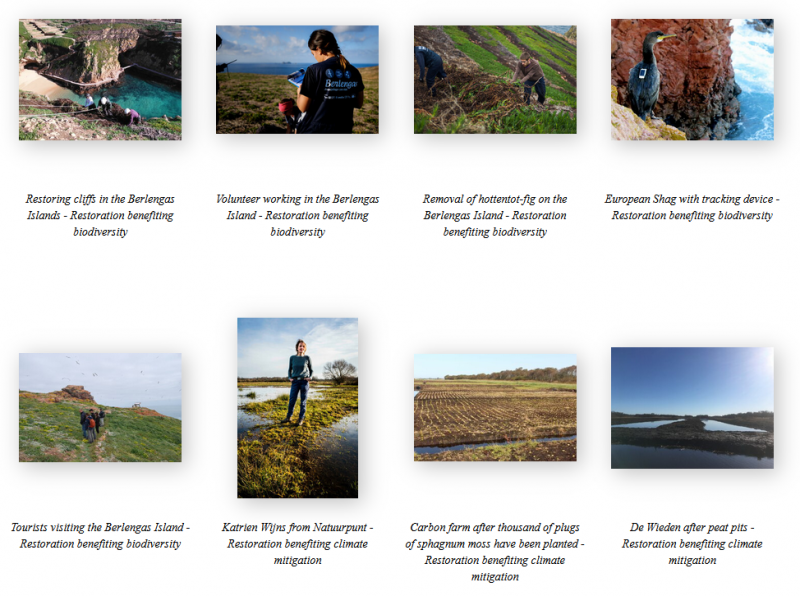
Mario Balzán
The Rewards of Nature Restoration webinar organised by BirdLife Europe, the Endangered Landscapes Programme and UNEP-WCMC has aimed to showcase what has already been done in nature restoration and to inspire people to do more. The participants of the webinar were people with experience on restoration actions on the ground, who presented some of the achievements obtained during their projects.
Speakers’ presentations
Martin Harper, Regional Director, Europe & Central Asia, opened the webinar by dedicating a few thoughts to the war in Ukraine and the impact this has had on colleagues and public life and how it has hampered conservation action carried out in Ukraine.
Dr David Thomas, Director of the Endangered Landscapes Programme (Cambridge Conservation Initiative) then addressed the webinar by describing the importance and benefits of nature restoration. As part of the webinar’s objective to showcase the rewards of nature restoration, a digital photo exhibition was shared during this event.
Photos from the exhibition can be accessed here.
Subsequent presentations focused on ongoing nature restoration work and highlighted some of the benefits of restoration. The presentation by Katrien Wijns, Coordinator of the Interreg Care-Peat project, focused on the restoration of the carbon storage capacity of peatlands. Peatlands are a carbon sink, but degraded peatlands are turned into a carbon source due to drainage for forestry, agriculture and peat extraction. Restoring peatlands presents many benefits to society, including clean air and carbon sequestration. The main objectives of the project are to demonstrate restoration techniques and methods to restore and improve carbon sequestration in peatlands, develop reliable measuring methods and predictive models of C-fluxes in peatlands, and identify socio-economic models and practices to promote peatland restoration. The project has 9 pilot sites in Belgium, the Netherlands, France, Ireland, and the United Kingdom, and its vision is to scale up peatland restoration in Europe.
Zafer Kizilkaya, President of the Mediterranean Conservation Society and manager of the Gökova Bay project described how in 2008 the fishing collapsed primarily because of overfishing by trawlers but also due to invasive species. During a fish biomass survey of the Northern Mediterranean coasts, Gökova Bay had fish biomass of 4 g/m2 among all Mediterranean MPAs (the lowest from all surveyed sites). Nature conservation and restoration action was carried out as part of the establishment and management of protected areas. Mr Kizilkaya explained how the key to success has been the acheivement of a good level of enforcement and the involvement of the communities. In 2017, the total fish biomass increased to nearly 80 g/m2, and the endangered sandbar sharks population increased threefold. There are now 9 monk seals in Gökova Bay now compared to 2 in 2010. Socio-economic monitoring reveals 400% increase in small-scale fisheries, with larger fish being caught, and increases in monthly income per boat being recorded between 2013 and 2017 while the project is promoting the use of invasive fish species for public consumption through the help of chefs and hotels and restaurants.
Open plenary speakers’ debate
Some main insights arising from the discussion:
Andrea Vettori, Member of Commissioner Sinkevičius cabinet in charge of the Biodiversity and Nature Protection portfolio, explained how the new Nature Restoration Law will have ecosystem specific targets and will focus on the involvement of local stakeholders as part of ambitious nature restoration plans with long-term objectives. Since most of the EU land is privately owned, it is also key to engage and work with land owners. In her words, policy coherence is really a crucial barrier and the most difficult to tackle.
Jutta Paulus, Member of the European Parliament, Shadow rapporteur for the Greens group on the Nature Restoration Law, explained that a clear definition of restoration, as well as ambitious and binding targets, supporting measures and financing are needed. Supporting measures and finance were also one of the identified gaps; taking into account the local population/ businesses is crucial. According to the speaker, LIFE programme is not enough to support Member States restoration actions, enforcement is the problem is still a missing point.
Evelyn Underwood, Head of Programme, Biodiversity and Ecosystems, Institute for European Environmental Policy (IEEP), presented some of the recent work by the IEEP, and explained that restoring habitats listed under Annex I of the EU Habitats Directive has great potential to deliver important climate mitigation benefits as well as restore biodiversity.
Sommer Ackerman, Environmental activist, looked at Europe’s track record and explained that over the past years it has taken member states a lot of effort to restore nature, but achievements were often counteracted by the fact that we seem to continue losing nature at faster rates, often as a consequence of EU inconsistent policies and funding itself. Inconsistent policies
Ariel Brunner, Senior Head of Policy, BirdLife Europe & Central Asia, explained that the EU has a poor track record with enforcing nature legislation. The biggest question is whether the Nature Restoration Law can be enforced and lead to action on the ground now. He also remarked that while headline targets show important ambitions for the EU, there is the possibility that we have entered an era of greenwashing, as these targets are often fakeable or become watered down at EU or member state level. Mr Brunner also argued that Europe may be giving the wrong subsidies to the fishing and farming sectors, as these may be leading to negative impacts on ecosystems, under the pretext of food security.
If you are interested and want to know more, you can access the full recording of the session on Youtube.

